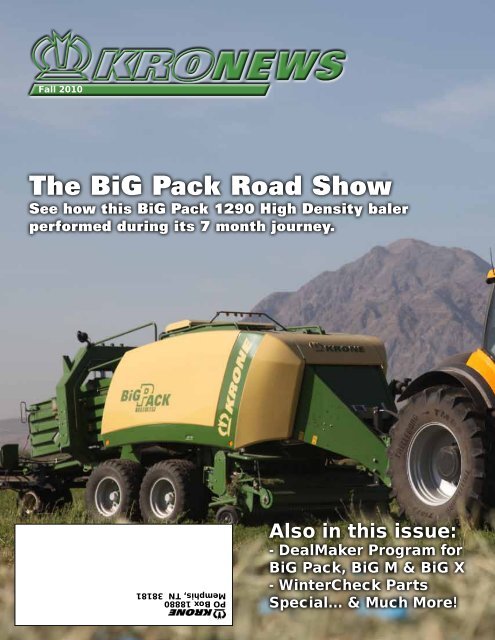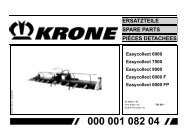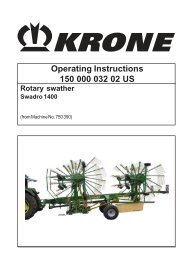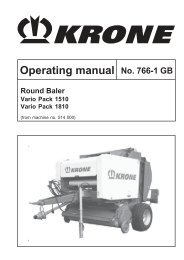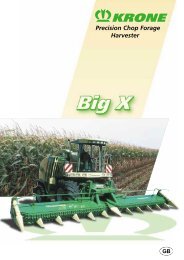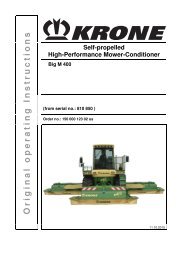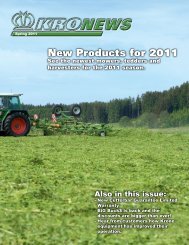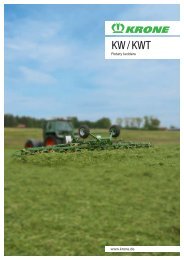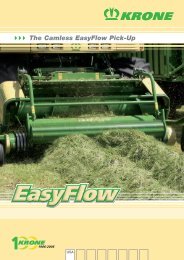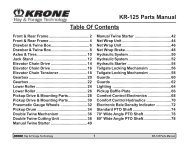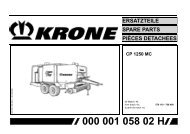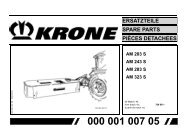The BiG Pack Road Show - Krone North America
The BiG Pack Road Show - Krone North America
The BiG Pack Road Show - Krone North America
Create successful ePaper yourself
Turn your PDF publications into a flip-book with our unique Google optimized e-Paper software.
Fall 2010CONTENTSNEWS<strong>The</strong> <strong>BiG</strong> <strong>Pack</strong> <strong>Road</strong> <strong>Show</strong>Pg. 6“I never would have thought tenyears ago that we could chop theamounts that we are choppingtoday.”-Mark Deardorff, <strong>BiG</strong> X Owner<strong>BiG</strong> X owners Mark & Loretta Deardorff andDoug Vondy tell their <strong>BiG</strong> X success stories.Pg. 4<strong>The</strong> Future of the Dairy MarketAre milk prices going up or down? Findout the latest.Pg. 10Why Wheatlage?Find out how switching to wheat silage canaffect your operation.Pg. 9EARLY ORDER PROGRAMBuy Nowand Save!<strong>The</strong>re’s no better time than now to choose <strong>Krone</strong>. <strong>The</strong> DealMaker Early Order Programoffers competitive pricing and low interest rates to those that order in the months ofOctober - December 2010. DealMaker is available on <strong>BiG</strong> <strong>Pack</strong> Large Square Balers, <strong>BiG</strong>M Self-Propelled Mower Conditioners, <strong>BiG</strong> X Forage Harvesters, EasyFlow Hay Headsand EasyCollect Corn Heads.2 - KroNews
In their own words...Doug VondyWoodrow, ColoradoOwner of: <strong>BiG</strong> X 800 & <strong>BiG</strong> X 650Sold & Serviced By: Wickham Tractor CompanyFort Morgan, ColoradoI am the proud owner of two <strong>Krone</strong> <strong>BiG</strong> X Forage Harvesters.We have had really good luck with both machines, andthey keep our trucks busy from sun-up to sun-down. I am veryimpressed with their capacity, chop quality, and fuel efficiency.<strong>The</strong> feed roll cabinet is a superior feature on the <strong>BiG</strong>X. When we are chopping haylage, the material doesn’t wrapin the feed roll cabinet like I experienced with my previouschoppers. Also, having six pre-compression rolls is a very nicefeature. I have really noticed that I get a better chop quality inhaylage because of it.We are very impressed with the X-treme wear partspackage. <strong>The</strong>se parts coming standard in the machine savesmy operation time and money. <strong>The</strong>se hard-faced parts are verydurable, and they allow us to run longer without replacing thesecommon wear items. <strong>The</strong> longevity of the X-treme wear partsis substantial, and my operation has seen huge cost savingsbecause of them.<strong>The</strong> EasyCollect header is the best corn header on themarket in my opinion. <strong>The</strong> ease of use, simplistic design andfeeding really stand out over the competition. I truly believethat the way the EasyCollect header feeds the crop into the feedrolls is what results in a superior product coming out the spout.Mark and Loretta DeardorffDeardorff Family FarmsMacy, IndianaOwner of: <strong>BiG</strong> X 1000Sold & Serviced By: Parker & Sons EquipmentClaypool, IndianaIf you would have asked Mark Deardorff three yearsago if he would ever own a <strong>Krone</strong> Forage Harvester, he wouldhave told you no. He was quite pleased with the unit he hadat the time. However, his local <strong>Krone</strong> dealer, Parker & SonsEquipment, kept inquiring about demonstrating a <strong>BiG</strong> X on hisfarm. Mark finally agreed and they demonstrated a unit similarin size to what he was running, a <strong>BiG</strong> X 800, and an EasyCollectCorn Head that was two rows wider than the head currentlyon Mark’s chopper. During the demonstration, Mark liked the<strong>BiG</strong> X so much that he didn’t want to get out. After this experience,Mark took a longer and harder look at the <strong>BiG</strong> X. Marksays, “I really liked what I saw and was really impressed withthe design of the <strong>BiG</strong> X. <strong>The</strong> <strong>Krone</strong> is a lot heavier built thanthe competition. This helped me make my decision to purchasea <strong>BiG</strong> X.”<strong>The</strong> Deardorffs chop eight hundred acres of hay fivetimes a year as well as eleven hundred acres of corn for silage.<strong>The</strong>y milk six hundred cows of their own. Deardorff FamilyFarms also provides corn silage for a two thousand cow dairy inthe area and haylage for a thirty-five hundred cow dairy. This isthe reason they chose to purchase the <strong>BiG</strong> X 1000 instead of the<strong>BiG</strong> X 800 that they had demonstrated.“I never would have thought ten years ago that wecould chop the amounts that we are chopping today,” saysMark. He claims that his biggest day was when they choppedover five hundred acres of haylage. This statistic is very impressiveto most.Mark is also very pleased with the level of service theyare receiving from Parker & Sons and <strong>Krone</strong>. “Dealer service isexcellent!”Mark explains, “At the end of the day it all comesdown to efficiency. My overall efficiency has drastically increasedwith the <strong>Krone</strong> <strong>BiG</strong> X 1000. <strong>The</strong> faster I can cut, chop,haul, and get the product into storage, the better quality of feedI will have. What we are chopping now will be your feed forthe next year. <strong>The</strong> better job we do now, the better things willbe next year at this time.”4 - KroNews
Fall 2010 - 3
<strong>The</strong> <strong>BiG</strong> <strong>Pack</strong> <strong>Road</strong> <strong>Show</strong><strong>The</strong> <strong>Krone</strong> <strong>BiG</strong> <strong>Pack</strong>1290 HDP Large Square Baleris a unique baler. It can produce a3’ x 4’ bale that weighs as much as a 4’x 4’ bale. This means at the end of theday you have 25% less bales on yourfield, on the truck and in your stock, butthe same amount of tons. This results infewer bales to handle, truck and storesaving operators a significant amount ofmoney.Saying that a 3x4 bale can weighas much as a 4x4 is a <strong>BiG</strong> claim. Toprove it, <strong>Krone</strong> set out on a seven-monthtour to show producers that the <strong>BiG</strong> <strong>Pack</strong>1290 HDP really can out bale the competition.<strong>The</strong> <strong>BiG</strong> <strong>Pack</strong> <strong>Road</strong> <strong>Show</strong> beganin early April with Niklas Beindorf, a<strong>Krone</strong> Germany employee, doing thedemonstrations. <strong>The</strong> goal of the <strong>Road</strong><strong>Show</strong> was to do as many demonstrationsas possible while traveling throughCalifornia, Oregon, Washington, Idaho,Nevada, Utah, Wyoming, Coloradoand Kansas. With a JCB 8250 Fastrac,equipped with a bale scale on the front,and a <strong>BiG</strong> <strong>Pack</strong> 1290 HDP, Niklasstarted off his adventure in early Aprilwith many miles ahead of him.<strong>The</strong> first stop was El Centro,Calif. in the Imperial Valley with the localdealer, Central Implement, and <strong>Krone</strong>Product Manager, Blake Fuller. <strong>The</strong>demos were a great success and the <strong>BiG</strong><strong>Pack</strong> showed that it is the heavy weightchampion. Customers at the demoswere impressed with the bale shape andweights. At one demo the BP 1290 HDP6 - KroNewswas making 7’ bales of Alfalfa at 12%-13% moisture that weighed in at 1,800pounds. With the bale scale on the frontof the tractor, it was possible to show thecustomers the bale weights right in thefield. This bale size and weight allowsthe customer to move them directly intocontainers for export and make full containerweights. A great cost savings forthe exporter.After finishing up the demos inthe Imperial Valley, the <strong>BiG</strong> <strong>Pack</strong> <strong>Road</strong><strong>Show</strong> moved on to Bakersfield,Calif. to meet up with Pioneer Equipmentand Brent Raines, Western RegionProduct Manager. Niklas got to enjoythe sights of southern California as hedrove the JCB tractor for the 360 mile,10 hour trip from El Centro to Bakersfield.He found that the tractor movesvery nicely and surprised several truckdrivers on steep grades as he passedthem with ease. It’s nice to have a tractorwith a 44 mph top speed!Once in Bakersfield, the Big<strong>Pack</strong> <strong>Road</strong> <strong>Show</strong> was put on hold as therains came. Once the show resumed itwas one great performance after another.At one demo, the <strong>BiG</strong> <strong>Pack</strong> reallyshowed what it could do. Niklas wasDemo in California for a customer whoexports bales overseas in containers.able to go 16 mph and produce anaverage bale weight of 1,844 pounds. Acompetitive baler in the same field couldonly travel 9 mph and the average baleweight was 1,523 pounds. This customerwas not only impressed with the heavierbales, but also the smooth running of themachine and the camless pickup, whichprovides a nice, constant flow of cropinto the machine without leaving any haybehind.<strong>The</strong> JCB tractor is equipped with abale scale on the front hitch for weighingbales in the field.Finishing the month of May inCalifornia, it was over to a neighboringstate for a whirlwind tour to prove theBP 1290 HDP can conquer the conditionsin Nevada. Having great dealersupport from Dan Smith of Smith ValleyGarage, the <strong>BiG</strong> <strong>Pack</strong> <strong>Road</strong> <strong>Show</strong> performedat least one demo per day for twoweeks. One demo was in a really roughfield, but the steered tandem axle of the<strong>BiG</strong> <strong>Pack</strong> helped provide a smootherride. At this demo Niklas was able to go12 mph, twice as fast as the competitivebaler, and he dropped 53 bales in lessthan an hour, including stops. Needlessto say, the customer was extremelyimpressed.
Checking out a bale made during a demoin Nevada.<strong>The</strong> first stop in Oregon for the<strong>BiG</strong> <strong>Pack</strong> <strong>Road</strong> was with Klamath BasinEquipment located in Klamath Falls.Chuck Day and Tom Downs put togethera great set of demos all over the KlamathBasin and Christmas Valley. <strong>The</strong>highlight of the week was working in anirrigated pivot that was over one mileacross. It was very impressive to see the<strong>BiG</strong> <strong>Pack</strong> moving across the field makingtight, dense bales. <strong>The</strong> customer wasalso very impressed. At one point whenstanding next to the baler, he asked Niklasto engage the pto, and to his surpriseNiklas told him the baler was alreadyrunning. <strong>The</strong> quiet, smooth running ofthe <strong>BiG</strong> <strong>Pack</strong> is due to the large, 1,600pound flywheel.Moving on to the ColumbiaBasin in Washington, Niklas encountereda challenge that would test his skill asan operator of the BP 1290 HDP, balingblue grass. This crop has been describedas baling rubber bands due to its abilityto spring back after being compressed.<strong>The</strong> demo started with six broken balesbefore Niklas dialed in the perfect tensionsetting to maximize bale weightsand still be in the limits of the twine.Once that level was reached it was off tothe races. <strong>The</strong> BP 1290 HDP was ableto produce a nice 1,200 pound bale. Thisseemed light until it was compared to the1,000 pound bales the customer’s balerproduced. This demo was a great test forthe <strong>Krone</strong> twine, as it was tested to itsmax and found to be up to the challenge.<strong>The</strong> <strong>Road</strong> <strong>Show</strong> spent the nextweek in Washington with EvergreenEquipment in Othello, but due to the wetspring, the hay crops were about one totwo weeks behind for wheat straw andright between alfalfa cuttings so thedemo opportunities were scarce. It wasa slow week, but the few demos that didtake place were very productive. <strong>The</strong>following week the <strong>Road</strong> <strong>Show</strong> moveda little south to join up with Kirk Oswaltof Farmers Equipment, who was ableto keep Niklas busy for a whole weekand then some! At one demo the <strong>BiG</strong><strong>Pack</strong> began baling 30 minutes behindtwo competitive balers. At the end ofthe demo the <strong>BiG</strong> <strong>Pack</strong> had dropped78 bales and the competitive machineshad only done 68 bales each, and whenweighing the bales the competitive machinesaveraged 1,250 pounds while the<strong>BiG</strong> <strong>Pack</strong> averaged an impressive 1,850pounds per bale. When the customer ranthe numbers he realized that he would beable to replace his three competitive balerswith two <strong>BiG</strong> <strong>Pack</strong> 1290 HDP’s andproduce the same amount. This will savehim the expense of a third tractor and allthat extra fuel.<strong>The</strong> <strong>BiG</strong> <strong>Pack</strong> <strong>Road</strong> <strong>Show</strong>’s arrivalin Idaho marked the start of manyBaling alongside a pivot.StateNo. ofDemosstraw demos. <strong>The</strong> <strong>BiG</strong> <strong>Pack</strong> was able toachieve average bale weights of 1,140pounds compared to the competitivebaler’s 850 pounds.Niklas and the <strong>BiG</strong> <strong>Pack</strong> <strong>Road</strong><strong>Show</strong> wrapped up their demos in Coloradothe first week of October. <strong>The</strong>re theygot to bale cornstalks, averaging 1,530pounds per bale, and sorghum, averaging1,720 pounds per bale. <strong>The</strong> <strong>BiG</strong><strong>Pack</strong> excelled in both conditions and thecustomers were very impressed.<strong>The</strong> Big <strong>Pack</strong> <strong>Road</strong> showcontinues and Niklas will have manymore great adventures on the road beforeending his adventure in Kansasin late October. You can catch all ofthe adventures of Niklas and the <strong>BiG</strong><strong>Pack</strong> <strong>Road</strong> <strong>Show</strong> on the <strong>BiG</strong> <strong>Pack</strong><strong>Road</strong> <strong>Show</strong> blog :roadshow2010en.blogspot.com/No. ofBalesHeaviestBaleCalifornia 25 1,597 2,165 lbs.Nevada 13 1,619 2,080 lbs.Oregon 7 240 2,138 lbs.Washington 9 551 2,165 lbs.Idaho 14 950 1,852 lbs.Utah 13 412 2,400 lbs.Colorado 6 270 1,962 lbs.Total 87 5,639Fall 2010 - 7
8 - KroNews
Why Wheatlage?By Dean HauserCorn silage has been a popular feedstuff for the beef cattleindustry for many years. Only recently has wheat silage,or wheatlage, become another popular feedstuff. Since allsilage is used for roughage in beef cattle rations, wheatlagecan be used as a direct replacement for corn silage. Ihave been wondering why some producers have made theswitch. I inquired to industry personnel to find out why.Why should a producer switch to wheatlage?<strong>The</strong> first reason for the change is cost. Input costs forwheatlage are less than corn, reducing risk for the grower.Since the input costs are lower than corn, it becomes amore competitive option for feed yards looking to reducefeed expenses.Another reason to switch to wheatlage is that it’s harvestedin the spring, opposed to corn silage harvest in thefall. Having another harvest window helps spread risk,helping the grower and the feed yard with their respectiverisk management strategies. Wheatlage also helps the feedyard with its inventory management. <strong>The</strong>y can purchaseless corn silage in the fall because they will have anotherharvest before corn silage harvest one year in the future.Also, since wheatlage is harvested relatively early in thespring, the grower can plant a summer crop. This allowsthe grower to maximize revenue and profits per acre.When comparing the actual feed, wheatlage has a greaterroughage content than corn silage, but this comes at thecost of energy content. However, for beef cattle rationsenergy can be added in other ways.Harvesting Wheatlage<strong>The</strong> <strong>BiG</strong> M 400 really excels in wheatlage. With up to a32 foot cutting width and the ability to put all of the cropinto one swath, one <strong>BiG</strong> M 400 can cut enough wheat tosupply two forage harvesters. It is available with steelrollers or V-tine conditioners. <strong>The</strong> conditioners do an excellentjob of preparing the crop for quick dry down. <strong>The</strong>cutting height is adjustable from the cab, so the stubbleheight is always right, and there is a memory functionthat will save two different cutting heights, allowing theoperator to quickly change to leave the desired amountof stubble. <strong>The</strong> front axle suspension increases operatorcomfort, resulting in less operator fatigue.<strong>The</strong> <strong>BiG</strong> M 400 has the capacity of 2 conventional windrowers.Since the <strong>BiG</strong> M 400 can put all of the crop inone windrow, a tractor and rake can also be eliminated.This allows one operator and one machine to do the workof three operators and three machines. <strong>The</strong> obvious savingsis in labor costs, however fuel costs on a per acre andper ton basis are also reduced.<strong>The</strong> machine has two different operating modes: field androad. In field mode, top cutting speed is 12 mph. Engineoperating speed is 1900 RPM. In road mode, top speed is25 mph. Also in road mode, engine speed is adjusted automatically,with top operating speed of 1600 RPM. Thisresults in fuel savings and decreased noise levels. Evenwith a cutting width of up to 32 feet, the machine folds toa transport width of less than 10 feet. This makes movingfrom field to field much easier and safer than competitivemachines.Wheatlage is a great fit for the beef cattle industry. <strong>The</strong><strong>BiG</strong> M 400 is a great fit for wheatlage. Great partners!<strong>The</strong> innovative SafeCut disc protection system from <strong>Krone</strong> offers effective protectionand peace of mind. Rather than transferring the shock load of the impact to thecutterbar, the system transfers the load to a roll pin, which breaks as a result of theimpact. <strong>The</strong>n the disc moves 0.6 inches up on its threaded drive pin and clears outof the risk zone and away from the neighboring discs.SafeCut is now available on all <strong>Krone</strong> <strong>BiG</strong> M’s, EasyCut 3-Point Disc Mowers,EasyCut Pull-Type Disc Mowers and EasyCut Pull-Type Disc Mower Conditioners.Fall 2010 - 9
<strong>The</strong> Future of theDairy Market By: Blake FullerSome of you are probablywondering which way the dairy pricesare going to go in the next couplemonths. Are they going to go up?Are they going to go down? Well,as a Territory Product Manager for<strong>Krone</strong> <strong>North</strong> <strong>America</strong>, I have talkedto a lot of people and done a lot ofresearch to answer this question foryou. I found a lot of good informationin an article written by RobertCropp of the University of Wisconsin-Madison with reference to the outlookof the dairy market. I want to thankhim for writing this article.According to the ChicagoMercantile Exchange’s website, ClassIII milk was at $16.34 per hundredweighton September 14th, 2010.October 2010 milk is up to $16.58 perhundredweight, but after December2010, the futures market drops backoff into the $14’s.In August, we saw an increasein milk production from a year ago.Statistics show that this increase is approximately3%, the largest increasethis year. <strong>The</strong> reason for this increaseis attributed to higher milk productionper cow and an increase in thenation’s cow herd. <strong>The</strong> cow herd inthe U.S. has increased close to 65,000head since last December.Milk prices continue to improveover a year ago. July Class IIIprice was $13.74, $3.77 higher thanthe $9.97 a year ago. August ClassIII milk was above $15.10 comparedto $11.20 a year ago. Cheese priceshave strengthened and the dry wheyprice has stayed steady in the $.40 perpound range. Cheddar barrels were at$1.56 per pound or higher during themonth of August, improving from anaverage of $1.36 per pound in June.Total cheese production was 5.2%higher and second quarter cheeseexports are up 87% from a year ago.CME butter prices are at levelsnot seen since June of 2004. <strong>The</strong>reis a strong demand for cream for icecream and other class II products.June butter production was 5.6%lower than a year ago and June 30thbutter stocks were 24.7% lower than ayear ago. Butterfat exports have beenstrong with second quarter exportsup 218% from a year ago. <strong>The</strong>re is aconcern that these prices may dampenretail sales. December cash-settledbutter futures are settling at $1.77 perpound.Nonfat dry milk powderexports were 76% above a year agofor the second quarter, but worldprices have softened and exports maybe slowing. Western nonfat dry milkprices were $1.30 per pound at theend of June. <strong>The</strong>y are now in the$1.15 range. June 30th nonfat drymilk stocks were 13.2% lower than ayear ago but building with stocks 18%higher than May.<strong>The</strong> question we all want answeredis will milk prices continue tostrengthen throughout the rest of theyear? <strong>The</strong> following factors point tofurther increases in milk prices withClass III futures reaching the high$15’s: lower than normal milk compositionreducing the yield of manufacturedproducts per 100 pounds ofmilk; the normal seasonal decline inmilk production; more hot and humidweather that depressed milk per cow;the opening of schools which increasesfluid (beverage) milk sales andcheese sales; the completion of the10th round of CWT removing morethan 34,000 cows; and anticipateddairy exports continuing above levelsa year ago.Crucial to higher milk prices isthe level of total milk production. <strong>The</strong>level of milk production will continueto depend upon whether thenation’s cow herd continues to buildas well as how much milk each cow isproducing. Prior to the 10th round ofCWT, cow slaughter was running belowa year ago. July 1st cattle inventoryshowed dairy replacements 3%higher than a year ago averaging 44.5per 100 milk cows compared to 42.9a year ago. <strong>The</strong>re is the potentialthat milk production could continueto run close to 2% higher than a yearago. This will challenge much highermilk prices unless domestic demandand exports improve more than nowexpected. Fluid milk sales as wellas <strong>America</strong>n cheese sales have beenrunning a little below a year ago, butsales of other cheeses have been muchimproved over last year.<strong>The</strong> continuation of higherdairy exports will be important inmaintaining and further strengtheningmilk prices for the remainder of theyear. I foresee Chinese milk importsto continue to increase due to high demand.This could help the domesticdairy market. <strong>The</strong>re have also beentalks of the U.S. government gettinginvolved to try and stabilize the dairymarket. <strong>The</strong> increase in the price ofcotton will take many acres out of hayproduction. With the decrease in hayacres and the increase in dairy prices,this should bode well for hay growers.Class III futures are settling above$15.00 through December, but backinto the $14’s at the start of 2011.<strong>The</strong>re is still a good possibility thatprices could do better than this.10 - KroNews
Up Coming EventsAg Connect Expo - January 7-10, 2011 - Atlanta, GeorgiaAg Connect Expo is a world-class trade show and education program offering not only the latest technology andproducts, but also quality learning and networking opportunities. <strong>The</strong> event is filled with exhibitors and expertsfrom the U.S. and around the world. <strong>Krone</strong> will be exhibiting our newest products and will have product expertsfrom <strong>Krone</strong> NA and <strong>Krone</strong> Germany available to answer any questions. For more information on Ag Connect, visitwww.agconnect.com.World Ag Expo - February 8-10, 2011 - Tulare, CaliforniaWith 2.6 million square feet of show grounds and 1,600 exhibitors, World Ag Expo is an industry leader in agricultureexpositions. Attracting an annual average of 100,000 attendees, this three day expo transforms Tulare, Californiainto the World’s hot spot for agriculture technology and innovation. Visit the <strong>Krone</strong> lot and speak with ourproduct experts and see the newest machines <strong>Krone</strong> has to offer.National Farm Machinery <strong>Show</strong> - February 16-19, 2011 - Louisville, Kentucky<strong>The</strong> future of farming is coming to the 45th National Farm Machinery <strong>Show</strong>, as the nation’s largest indoor farmshow returns to the Kentucky Exposition Center. Start the year with row after row of quality products and services,hands-on demonstrations of the latest technological advancements, and a variety of free seminars. While at theshow, make sure to stop by the <strong>Krone</strong> booth to visit with product experts and see the newest in <strong>Krone</strong> innovation.Fall 2010 - 11
Looking for machinery to improve the performanceand productivity levels in your operation?We invite you to see how <strong>Krone</strong> machines can make a difference for you. That difference can be a higher chop quality,a tighter bale, a uniform windrow, a precision cut, increased capacity and many other advantages depending on the typeof machine you require. <strong>Krone</strong>’s development and growth in the <strong>North</strong> <strong>America</strong>n market has evolved as a result of innovationand technology designed to cut your cost per unit of production; cost per acre, cost per ton, cost per gallon orany measure you use to determine productivity levels.THE COMPLETE HAY SYSTEM<strong>Krone</strong>’s complete system of hay making machines can provideyou with a new level of high quality hay. <strong>Krone</strong> Mowersand Mower Conditioners provide a precision cut and highcapacity. <strong>Krone</strong> Rotary Tedders spread and condition thecrop for quicker dry down and faster haying times. <strong>Krone</strong>Rotary Rakes allow for earlier raking and provide uniform,low-density windrows for continued drying in the windrowand higher leaf retention. <strong>Krone</strong> Round Balers finish theharvest by providing high capacity baling and high-densitybales.<strong>BiG</strong> BALING with <strong>BiG</strong> PACK <strong>BiG</strong> SQUARE BALERSIf <strong>BiG</strong> Square bales are part of your operation <strong>Krone</strong> offers10 models with bale sizes of 3 X 3, Multi Bale models, 3 X4, and 4 X 4. Each model offers the special, and in somecases exclusive, features and benefits of the <strong>Krone</strong> <strong>BiG</strong> <strong>Pack</strong>Baler line.<strong>BiG</strong> MOWING with <strong>BiG</strong> M<strong>BiG</strong> means BIG and if you want <strong>BiG</strong>, Fast Mowing andConditioning take a look at the <strong>BiG</strong> M Self-PropelledMower Conditioner. You can cut and condition up to 32feet in one pass or up to 28+ acres per hour. Conditioning isdone with a V-Tine system, a crimping metal roller systemor a crimping rubber roller system. Work in the comfort of astate of the art cab with futuristic joystick controls. <strong>The</strong> first<strong>BiG</strong> M in <strong>North</strong> <strong>America</strong>, sold in 1998, is still running todayafter more than 100,000 acres.<strong>BiG</strong> HARVESTING with <strong>BiG</strong> X<strong>BiG</strong> goes even further with the <strong>Krone</strong> <strong>BiG</strong> X Self PropelledForage Harvester. With 4 models to choose from, <strong>Krone</strong>’s<strong>BiG</strong> X 1000 offers the largest Forage Harvester in the worldat 1020 horsepower (ECE R120). All that power can’t beutilized without a <strong>BiG</strong> Head and <strong>Krone</strong> offers it with theEasyCollect Corn Heads that come in sizes up to 12 rowsand in a flat fold design (12 row only), an industry first. <strong>The</strong>EasyCollect Heads in the 8-row design are also sold for useon competitive brands of Forage Harvesters.<strong>Krone</strong> equipment is manufactured in Spelle, Germanywhere the company is still run by the <strong>Krone</strong> family.<strong>The</strong> <strong>Krone</strong> <strong>North</strong> <strong>America</strong>n headquarters is locatedin Memphis, Tennessee.


